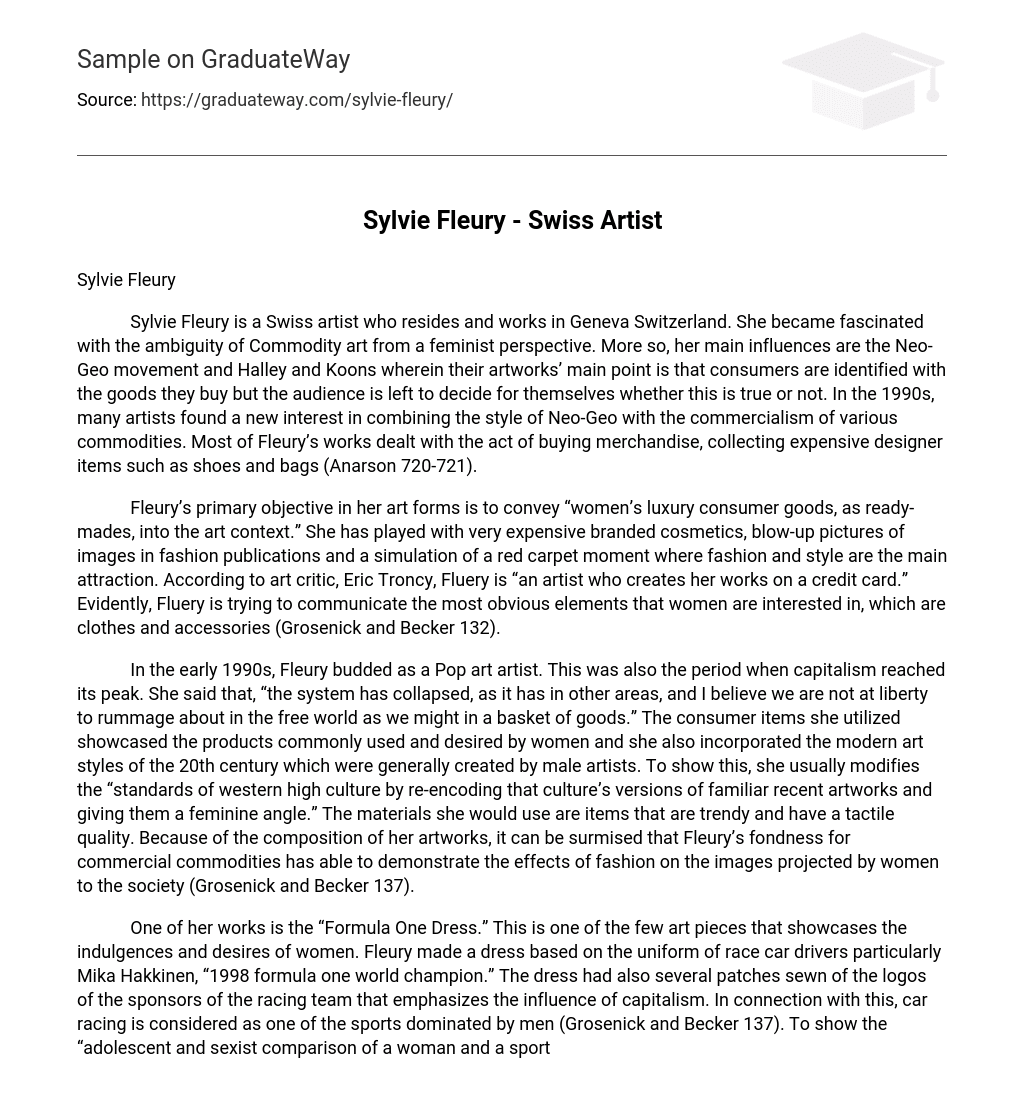Sylvie Fleury
Sylvie Fleury is a Swiss artist who resides and works in Geneva Switzerland. She became fascinated with the ambiguity of Commodity art from a feminist perspective. More so, her main influences are the Neo-Geo movement and Halley and Koons wherein their artworks’ main point is that consumers are identified with the goods they buy but the audience is left to decide for themselves whether this is true or not. In the 1990s, many artists found a new interest in combining the style of Neo-Geo with the commercialism of various commodities. Most of Fleury’s works dealt with the act of buying merchandise, collecting expensive designer items such as shoes and bags (Anarson 720-721).
Fleury’s primary objective in her art forms is to convey “women’s luxury consumer goods, as ready-mades, into the art context.” She has played with very expensive branded cosmetics, blow-up pictures of images in fashion publications and a simulation of a red carpet moment where fashion and style are the main attraction. According to art critic, Eric Troncy, Fluery is “an artist who creates her works on a credit card.” Evidently, Fluery is trying to communicate the most obvious elements that women are interested in, which are clothes and accessories (Grosenick and Becker 132).
In the early 1990s, Fleury budded as a Pop art artist. This was also the period when capitalism reached its peak. She said that, “the system has collapsed, as it has in other areas, and I believe we are not at liberty to rummage about in the free world as we might in a basket of goods.” The consumer items she utilized showcased the products commonly used and desired by women and she also incorporated the modern art styles of the 20th century which were generally created by male artists. To show this, she usually modifies the “standards of western high culture by re-encoding that culture’s versions of familiar recent artworks and giving them a feminine angle.” The materials she would use are items that are trendy and have a tactile quality. Because of the composition of her artworks, it can be surmised that Fleury’s fondness for commercial commodities has able to demonstrate the effects of fashion on the images projected by women to the society (Grosenick and Becker 137).
One of her works is the “Formula One Dress.” This is one of the few art pieces that showcases the indulgences and desires of women. Fleury made a dress based on the uniform of race car drivers particularly Mika Hakkinen, “1998 formula one world champion.” The dress had also several patches sewn of the logos of the sponsors of the racing team that emphasizes the influence of capitalism. In connection with this, car racing is considered as one of the sports dominated by men (Grosenick and Becker 137). To show the “adolescent and sexist comparison of a woman and a sport scar, she illustrated an image of herself defined by social prejudices and commercial products (Anarson 722). Moreover, she posed with Hakkinen on a race track with matching suits to clearly mark the difference between men and women. Fluery posed spiritedly despite the contradictions present in the photograph. This only shows that being educated about the difference forces of society does not automatically result to opposition; instead Fleury showed that sex and capitalism can be a source of power and pleasure for many women (Anarson 722). The “Formula One Dress” can be interpreted as a medium to portray the competitive nature of the relationship of men and women” or it could be a “reminder that the race for equal rights and opportunities is still being run” (Grosenick and Becker 137).
Works Cited
Anarson, H.H. History of Modern Art 5th Edition. USA: Prentice Hall, Inc. 2003.
Grosenick, Uta and Becker, Ilka. Women artists in the 20th and 21st century. Germany: Taschen, 2001.





